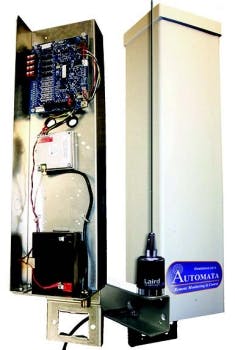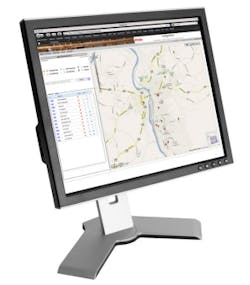Guide to Validating Smart Metering Business Decisions
By Brian Fiut
Utilities come in various shapes and sizes, but they all strive for essentially the same end result. They seek to deliver water to their customers in an efficient, safe manner while simultaneously protecting the utility's revenue stream, maintaining customer satisfaction, protecting their water supply, and minimizing expenses by increasing operational efficiencies. Water utilities are also concerned with future demands on their systems, replacing aging infrastructure, and potential future supply limitations.
In order to meet these challenging business objectives, the water industry has witnessed a growing trend toward deployment of fixed network-based metering systems. The 2009 Scott Report indicates fixed network shipments in North America were up more than 47 percent from 2008 to 2009 for water utilities. From 2004 to 2009, fixed network shipments for water modules resulted in a compounded annual growth rate of almost 60 percent.
IMS Research, a leading independent provider of market research to the global energy industry, predicts that by 2015, nearly 15 percent of all North American meters shipped will be two-way meters with advanced capabilities.
While many water utilities are already on board with these technologies, others are in the process of determining if a fixed network system is right for them. To validate the business case for deploying advanced metering infrastructure, utilities should ask the right questions and look at the benefits to determine if smart metering can help them achieve their current and future operational goals and objectives.
Discussing and answering specific questions at the enterprise level will help utilities begin the process of validating a smart metering deployment. Typical questions include:
- What cost-reducing measures related to meter reading (reduction in the number of meter reading field crews, vehicle operating and maintenance costs, CO2 emissions and liability claims) can the utility expect by deploying a smart metering solution?
- How will the customer service experience be enhanced?
- How can single and compound meter right sizing be analyzed?
- What operational advantages can by realized by analyzing the consumption data of grouped (aggregated) meters such as districts or zones?
- How can a utility reduce lost water and improve its image in the community by being able to discover "behind the meter" premise leaks or leaks within the distribution system?
- How will smart metering help the utility discover previously unaccounted-for water?
- Is reverse flow detection important and how does it work with a smart metering system?
- Are meters being tampered with on a routine basis and how can this be detected and monitored?
- How can smart metering monitor overall distribution system integrity?
- How can a utility quantify the before-and-after results of targeted conservation programs?
- How does integrated leak detection support conservation efforts?
A look at the benefits and costs of smart metering systems can help utilities answer these questions. When looking at potential benefits, utilities need an understanding of their operating characteristics and which aspects of automation will benefit them the most, prioritizing where they will deploy various advanced metering technologies to meet their operational objectives.
Cost Savings
When looking at smart metering, it is easy to see the reduction in basic meter reading costs. While the cost of meter reading can vary due to many factors, this is one of the main expenditures to be reduced through automation. Costs for manual reading typically range from $.50 to $3 per read depending on labor costs and distance between meters. By deploying advanced metering, costs associated with manual meter reading can be avoided including meter reading salaries, benefits, vehicle costs, and other general overhead expenses. Additionally, rising insurance costs and exposure to various liabilities are other reasons utilities want to reduce field service crews.
While the cost avoidance associated with basic meter reading may be apparent, there are other cost savings and revenue enhancements that can be realized from an advanced metering system, such as improving the overall operations of a utility, helping maintain system integrity, and enhancing the customer service experience
Enhanced Customer Service
Having more data available allows a utility's Customer Service Representatives to share consumption information with their customers to more quickly and easily resolve billing disputes. This ability to reconcile billing questions on any given day, for any given hour using actual consumption data at a granular level can help assure utility customers that their bills and meter reads are accurate. Accuracy and responsiveness to customer inquiries increases consumer confidence and helps the utility eliminate delayed payments and write-offs.
Meter Right Sizing
With meter data from certain products, like Itron's ChoiceConnect™ 100W two-way water module, engineers can perform detailed analysis of field assets to right-size single and compound meters and determine if the meter is over or underutilized in order to optimize asset utilization and billable flow through the meter.
District Metering Analysis
Advanced hourly meter data can also be used for detecting non-revenue water losses using district meter analysis, by aggregating time-synchronized interval reads from a feeder and subsequent "grouped" or "zoned" meters to locate water losses through analysis of the data.
In-Home and In-Business Leak Detection
Advanced metering data can detect in-premise water losses by using minimum flow rates that are analyzed against pre-set thresholds to recognize potential leaks. After an in-home alert is triggered, the utility can notify the customer to correct the leak, resulting in water loss reductions and avoidance of high bills.
Alternative Rate Structures
Incentivizing customers with different rate structures throughout the day is made possible with data logging. Time synchronized interval data enables time-based rate structures, as does the ability to store the data and organize it into specific billing determinants. Certain fixed networks offer the capability to do all of these things with streamlined, integrated meter data management targeted to the specific needs of the water utility.
Water Distribution System Optimization
Managing customer consumption efficiency is fast becoming one of the top concerns for water utilities as increase in demand strains finite resources. Having important information such as reverse flow alerts and granular data for improved hydraulic flow modeling calibration gives a utility the tools it needs to manage and optimize their distribution system.
Move-In/Move-Out Readings
No need to send a meter reader out for unscheduled reads anymore. Now a utility can conduct "virtual disconnects" and reconnects using an AMI system's advanced two-way capability to extract the most current read during move-ins or move-outs, as well as offering the ability to monitor the account while in an inactive status for unauthorized consumption.
Acoustic Leak Detection
Data from other advanced metering devices such as acoustic leak monitoring systems plays an important role in the analysis of distribution system leaks. Bringing back actual sound recordings of leaks, as opposed to a simple detection flag, enables advanced analysis at a utility to better understand the severity of a leak. This in-depth interrogation and interpretation of the data increases the accuracy of readings to properly reflect real leaks while minimizing false readings.
System Migration
Some companies offer water meter modules that can be read via a fixed network as well as mobile and handheld readers, and can do so without changing the endpoint hardware or sacrificing any of its advanced functionality. This offers a utility the ability to migrate from a mobile to a fixed collection environment at their own pace, or mix the two technologies, taking the risk out of an "all-or-nothing" decision to deploy one or the other collection technology.
Conclusion
By understanding the relative importance of the benefits outlined above, utilities can determine if a fixed network will fulfill their needs and validate the business case for deploying advanced metering infrastructure for their utility.
Once the benefits have been weighed and the cost savings analyzed, a utility can start the process of specifically defining their needs and identifying specific vendors and stakeholders involved to issue an RFP.
About the Author: Brian Fiut is a senior product manager with Itron Inc. and is responsible for the ChoiceConnect™ 100 Fixed Network solution. He has over 25 years experience working in the communications and utility industries.
More WaterWorld Current Issue Articles
More WaterWorld Archives Issue Articles



